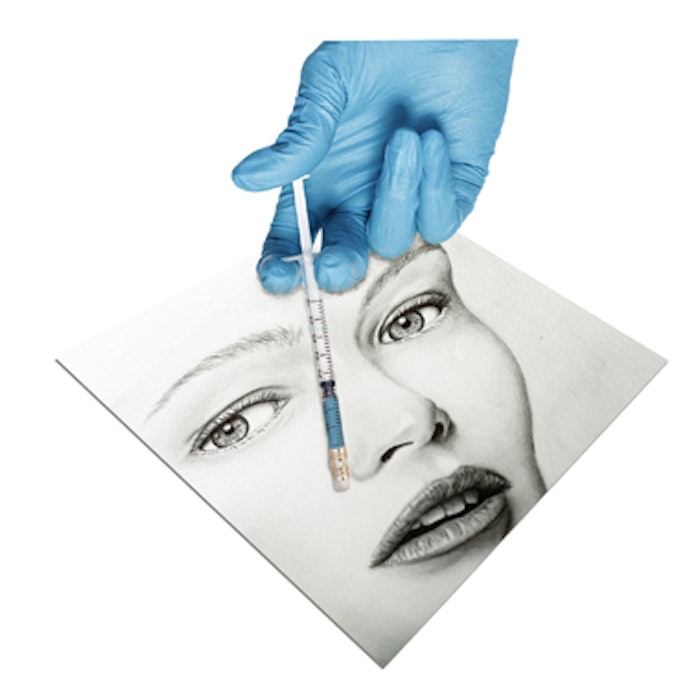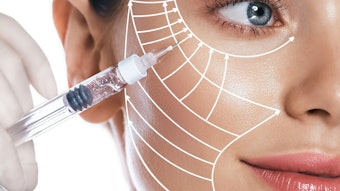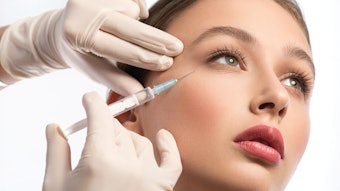
Bruises are a common side effect of injectable treatments, such as botulinum toxin and dermal fillers. In most cases, bruises are a natural part of the healing process, but they are troubling to patients eager to see immediate improvement in their appearances. That’s why experienced injectors are taking steps to identify those at the greatest risk for bruising and integrating new tools as well as pre- and post-care protocols to reduce the degree and longevity of postprocedure bruising.
Highest Risk for Bruising
Patients with fair and thinner skin who already have ecchymosis showing are especially prone to postprocedure bruising, says H.L. Greenberg, MD, founder of Las Vegas Dermatology in Las Vegas. “Also, anyone on a blood thinner such as Coumadin or Xarelto can bruise, as well as people who take aspirin.”
Certain areas of the face, including the lips and tear troughs, are also more likely to experience postprocedure bruising. “The lips are highly vascularized and the periorbital skin bruises because it is so thin,” says Dr. Greenberg.
In addition to thinner skin, the undereye area is also well vascularized. “Not only is any bleeding under the skin more easily seen in this area, but it also spreads rapidly into the surrounding tissue to create a ‘black eye’ appearance anytime a blood vessel is pierced,” says Robyn Siperstein, MD, founder of Siperstein Dermatology Group in Boca Raton, Florida.
Thinking Ahead
Several pretreatment techniques can help minimize bruising. Ruth Tedaldi, MD, of Dermatology Partners, in Wellesley, Massachusetts, encourages patients to avoid aspirin or any nonsteroidal anti-inflammatory for a week prior to treatment, if it is safe for them to do so.
“In terms of increasing bleeding time, these medications are active for about a week,” she says. “So we usually tell patients to stop a medication if it’s appropriate. If a patient takes a blood thinner because of a heart condition, for instance, we do not want them to stop taking that medication. But if they have a choice of taking Tylenol or ibuprofen or aspirin, I would tell them to take Tylenol the week before the injection.”
Dr. Tedaldi also encourages patients not to drink alcohol, which can increase postprocedure bruising, for two days prior to injections. “We also have them stop homeopathic remedies that can lead to more bruising, such as ginger and garlic,” she says.
Michael Gold, MD, founder of Gold Skin Care Center in Nashville ices the area prior to injecting. “Topical numbing medicine doesn’t do much to stop bruising,” he says. “But ice will actually help a little because it constricts some of the blood vessels. It’s not going to prevent bruising completely, but it does help.”
Dr. Siperstein finds that most medications that contain vasoconstrictors can be helpful, such as topical epinephrine added to numbing cream. “Even topical Afrin, which is known to help with nose bleeds, has been hypothesized to help reduce the potential for bleeding,” she says. “Vasoconstriction treatments shrink the blood vessels—the smaller they are, the less likely they will be hit by a needle, and less blood will flow into surrounding tissue.”
Injection Technique
Ten years ago, Dr. Siperstein would tell her patients there was a 50/50 chance they would have a black eye after their tear trough treatment. But with newer techniques, such as using a cannula and vein finder, her bruising rate is now less than 1 percent.
First, she uses a vein finder to ensure she is injecting in an area free of blood vessels; then she pierces the skin with a needle and inserts the cannula through the opening. “This technique results in a much lower potential for bruising,” she says. “Unfortunately, this technique cannot be used for fine lines, but it is great for volumizing.”
JoAn Monaco, MD, of Plastic, Reconstructive & Cosmetic Surgery in New York City, often uses a cannula for filler injections. “I particularly prefer using cannulas over needles when injecting the tear trough and the delicate skin under the eye and lateral canthus,” she says.
Even with cannulas and vein finders, bruising can happen, notes Dr. Greenberg. “We are sticking a needle in the face,” he says. “But I’ve found injecting slowly helps.”
Dr. Tedaldi agrees. “The speed of the needle’s or cannula’s exit from the skin is the most important variable. The slower the better.”
During injection, Sheila Nazarian, MD, of Nazarian Plastic Surgery in Beverly Hills, California, reminds her patients to breathe. “Sometimes patients will tense up and bear down. It’s similar to when you bear down on the toilet. Your face gets red because you’re opening up all those blood vessels in the face. So it’s really important to remind patients to breathe so they don’t get red in the face as you’re injecting,” she says.
If any bleeding occurs during injection, Dr. Siperstein has her assistant immediately apply pressure to the area for five minutes to minimize the risk of bruising. “I always explain to patients why I am having my assistant hold pressure, and they are always very appreciative of our making every effort to limit their downtime,” she says.
Postprocedure Care
Postprocedure bruising may also occur due to swelling after the injection that causes the area to becomes congested, which can rupture small vessels. “It’s not unusual for a patient to leave your office bruise-free and then go home and swell up and wake up with a big fat bruise,” says Dr. Tedaldi. “So anything that reduces swelling post-treatment is of great value.”
She encourages her patients to use ice—never putting the ice directly on the skin, but rather, always having a thin layer of protection between the icepack and the skin. “We have them ice off and on for the rest of that day,” says Dr. Tedaldi. “We also ask the patient to avoid exercise, which will cause swelling and congestion, for at least 24 hours. If the injection was in the face, we ask the patient to sleep on an extra pillow so that the hydrostatic pressure from lying flat does not increase the likelihood of bruising.”
Dr. Greenberg also recommends the use of icepacks. He advises patients to apply them for 15 minutes on, 15 minutes off every hour for the first day. His practice also recommends an arnica blister pack product.
Oral arnica is typically taken at the time of injection and then every six hours after for a total of four tablets. Dr. Monaco offers SinEcch arnica packs, which the patient starts before leaving the office. “Arnica is an herbal supplement that has been found to be helpful with bruising,” she says. “Topical arnica is also worthwhile.”
Dr. Monaco and Dr. Nazarian both recommend OcuMend (Cearna Aesthetics), a hydrogel pad infused with arnica montana and ledum palustre. “This formulation of arnica has been found to be as much as 50 times more potent than other forms of arnica,” says Dr. Monaco. “I particularly love this product for periorbital ecchymosis that can happen after periorbital filler rejuvenation.”
“It looks like a de-puffing patch you that wear under your eyes,” says Dr. Nazarian. “It’s a great product because it allows patients to get treatment even a couple days before an event. It brings down the swelling and prevents bruising.” She sends patients home with enough patches to get them through the day and first night after treatment.
Dr. Siperstein recommends using postprocedure topicals with arnica, vitamin K and bromelain until all bruising is gone. She also advises patients not to exercise—especially upside down—until all bruising and swelling is gone. “Taking these proactive steps to limit physical activity will significantly reduce the likelihood of large areas of bruising, as increased blood flow and pressure will usually worsen a bruise,” she says.
Banishing Bruises
If a patient does experience bruising that lasts more than a few days, Dr. Siperstein offers complimentary intense pulsed light treatments. “This can cut down bruising time from seven to 10 days to three to four days,” she says.
“The simplest way to make a bruise go away is by using a laser light source,” says Dr. Gold, who prefers the Vbeam Perfecta or Vbeam Prima (Syneron-Candela). “One or two zaps is usually all that you need, and it helps the progression of the bruising go away a lot faster. Within several days, it’s gone.”
Dr. Greenberg uses the Cynosure 585nm pulsed dye laser with a 7mm spot at 7 J/cm2 and 10ms pulse duration.
Another alternative is the Aerolase LightPod Neo, a short-pulsed, 1,064nm laser. “This really works well,” says Dr. Gold. “I’ve used it to treat patients who underwent multiple injections throughout the face and were left bruised. Within a day or two, the bruises are gone.”
“Keep in mind, if you stick a blood vessel, there’s a chance you’re going cause bruising, no matter what pre-care treatment you use,” says Dr. Gold. But sudden bruising—especially if it is accompanied by pain—can be a sign of something much more serious. “If somebody gets a bruise, that’s OK,” he says. “But they should be instructed to call their provider immediately if they get a bruise associated with a lot of pain and discomfort, because you may be dealing with a vessel that’s occluded, and this can occur anywhere on the face.”
Daniel Casciato is a freelance writer based in Pittsburgh.
Image copyright Getty Images











